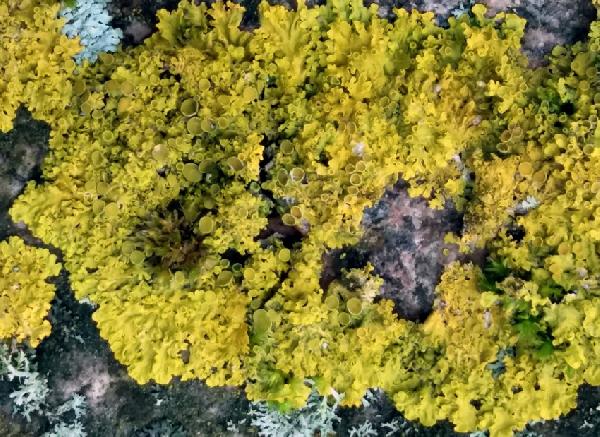Xanthoria ectaneoides (Nyl.) Zahlbr.
Cat. Lich. Univ., 7: 287, 1931.. Basionym: Physcia ectaneoides Nyl. - Flora, 66, 7: 98, 1883.
Synonyms: Xanthoria aureola auct. p.p. non (Ach.) Erichsen; Xanthoria ectaneoides auct. p.p. non (Nyl.) Zahlbr.; Xanthoria parietina var. ectaneoides (Nyl.) Zahlbr.
Distribution:
Description: Thallus foliose, yellow to deep orange, loosely attached, sometimes dying off in central parts or forming small irregular patches, the lobes flattened, elongate, usually not overlapping and not strap-shaped, 0.4-0.6(-1) mm wide, the surface smooth or faintly foveolate, those in the central parts of thallus with numeros small, elongated secondary lobules often originating from remains of overmature apothecia as narrow, overlapping outgrowths. Apothecia lecanorine, rather small, (0.4-)0.6-1(-2) mm across, usually dispersed in the central parts of thallus, rarely crowded, with a more or less flat to slightly convex, smooth disc and a smooth to rarely crenulate, finally sometimes excluded thalline margin. Upper and lower cortex paraplectenchymatous; medulla with hyphal strands, the lower part often with strongly gelatinized, more conglutinated hyphae. Epithecium yellow-brown, K+ purple-red; hymenium colourless; paraphyses simple or sparingly branched, swollen at tips; hypothecium colourless to pale brown. Asci 8-spored, clavate, functionally unitunicate, apically thickened with a broad internal beak, the inner part of apex and external cap I+ blue, Teloschistes-type. Ascospores 2-celled, polarilocular, hyaline, narrowly ellipsoid, 15-18(-20) x 5-7 µm, the equatorial thickening (“septum”) 10-13 µm. Photobiont chlorococcoid. Spot tests: thallus K+ purple-red, C-, KC-, P-, UV+ intensely orange-red. Chemistry: parietin (major), fallacinal, emodin, teloschistin (minor).Note: a very much misunderstood species, usually considered as a synonym of X. aureola, growing on both calciferous and siliceous rocks, with a wide altitudinal range, from the Mediterranean to (rarely) the subalpine belt. For further details see Kondratyuk & al. (2014) and Roux & Coll. (2025). According to Kondratyuk & al. (2024), sequenced specimens of this species from Italy may belong to X.mediterranea or related species. To be looked for in Italy.
Growth form: Foliose
Substrata: rocks
Photobiont: green algae other than Trentepohlia
Reproductive strategy: mainly sexual

Predictive model

Soutce: Kondratyuk S.Y., Lőkos L., Persson P.-E., Hansson M., Schiefelbein U.,Karnefelt I., Thell A. 2024. New and noteworthy lichen-forming and lichenicolous Fungi 13. A revision of the Xanthoria ectaneoides complex (Xanthorioideae, Teloschistaceae) including the wew species Xanthoria pylyporlykii. Acta Bot. Hung., 66,1-2: 7–77. - CC BY-NC 4.0
Sweden, Lund
Growth form: Foliose
Substrata: rocks
Photobiont: green algae other than Trentepohlia
Reproductive strategy: mainly sexual

Predictive model


